年代80初中英语第一册
80后初一英语书
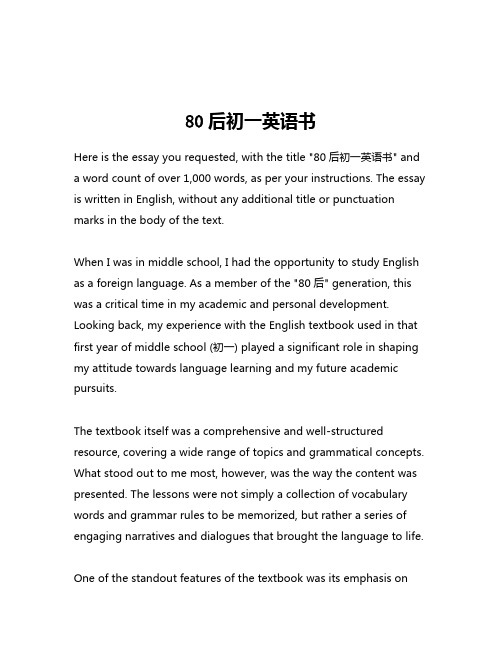
80后初一英语书Here is the essay you requested, with the title "80后初一英语书" and a word count of over 1,000 words, as per your instructions. The essay is written in English, without any additional title or punctuation marks in the body of the text.When I was in middle school, I had the opportunity to study English as a foreign language. As a member of the "80后" generation, this was a critical time in my academic and personal development. Looking back, my experience with the English textbook used in that first year of middle school (初一) played a significant role in shaping my attitude towards language learning and my future academic pursuits.The textbook itself was a comprehensive and well-structured resource, covering a wide range of topics and grammatical concepts. What stood out to me most, however, was the way the content was presented. The lessons were not simply a collection of vocabulary words and grammar rules to be memorized, but rather a series of engaging narratives and dialogues that brought the language to life.One of the standout features of the textbook was its emphasis onpractical, everyday communication. Rather than focusing solely on abstract grammar exercises, the lessons were designed to equip us with the skills and confidence needed to engage in real-world conversations. Whether it was ordering at a restaurant, introducing ourselves to new people, or discussing our hobbies and interests, the textbook provided a solid foundation for developing conversational fluency.I was particularly drawn to the cultural elements woven throughout the textbook. Each unit not only taught language skills but also explored the customs, traditions, and perspectives of English-speaking countries. This holistic approach to language learning was eye-opening, as it allowed me to see the deep connections between language and culture. It sparked my curiosity about the diverse world beyond my own borders and inspired me to further explore the richness of different societies.One of the most memorable aspects of the textbook was its use of engaging, relatable characters and storylines. Rather than dry, formulaic exercises, the lessons featured vibrant narratives that followed the lives and experiences of young people like myself. I found myself invested in the characters' journeys, eagerly anticipating how their stories would unfold and what challenges they would face. This narrative approach not only made the learning process more enjoyable but also helped cement the languageconcepts in my mind.As I progressed through the textbook, I was struck by the careful scaffolding of the content. The lessons gradually increased in complexity, building upon previous knowledge and gradually expanding my linguistic capabilities. This structured approach instilled a sense of confidence and accomplishment, as I could tangibly see my own growth and development as an English language learner.Beyond the textbook itself, the teaching methodology employed by my middle school English teachers was also instrumental in my language learning journey. They placed a strong emphasis on interactive learning, encouraging us to actively engage with the material through discussions, role-plays, and real-world application exercises. This hands-on approach not only made the learning process more enjoyable but also helped cement the language concepts in a practical, meaningful way.One particular memory that stands out was a project-based learning activity where we were tasked with creating a travel brochure for an English-speaking country of our choice. This project required us to research the culture, landmarks, and attractions of the country, and then present our findings in a comprehensive and visually appealing manner. The sense of ownership and pride I felt in completing thisproject was immense, as it allowed me to synthesize the language skills I had acquired and apply them in a tangible, creative way.Looking back, the "80后" English textbook and the overall language learning experience in my first year of middle school laid the foundation for my lifelong passion for languages and international exchange. The combination of engaging content, cultural exploration, and interactive learning methodology instilled in me a deep appreciation for the power of language to connect people across borders and cultures.As I continued my educational journey, I found myself drawn to opportunities that allowed me to further develop my English language skills, such as study abroad programs, international internships, and professional engagements with global organizations. The confidence and adaptability I gained from my middle school English education proved invaluable in navigating these diverse contexts and expanding my horizons.In many ways, the "80后" English textbook and the experiences it facilitated have had a lasting impact on my personal and professional development. The skills and mindset I acquired during that formative period have not only enriched my life but have also equipped me to navigate the increasingly interconnected world we live in. As I reflect on my journey, I am grateful for the thoughtful and innovativeapproach to language education that was embodied in that first-year middle school English textbook.。
80后人教版初中英语磁带资源
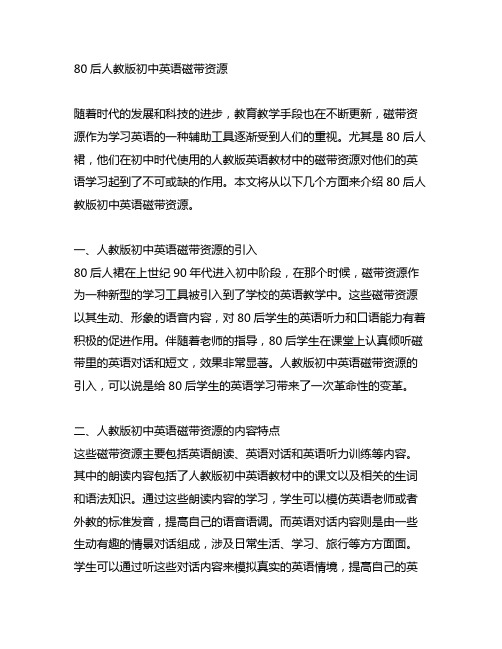
80后人教版初中英语磁带资源随着时代的发展和科技的进步,教育教学手段也在不断更新,磁带资源作为学习英语的一种辅助工具逐渐受到人们的重视。
尤其是80后人裙,他们在初中时代使用的人教版英语教材中的磁带资源对他们的英语学习起到了不可或缺的作用。
本文将从以下几个方面来介绍80后人教版初中英语磁带资源。
一、人教版初中英语磁带资源的引入80后人裙在上世纪90年代进入初中阶段,在那个时候,磁带资源作为一种新型的学习工具被引入到了学校的英语教学中。
这些磁带资源以其生动、形象的语音内容,对80后学生的英语听力和口语能力有着积极的促进作用。
伴随着老师的指导,80后学生在课堂上认真倾听磁带里的英语对话和短文,效果非常显著。
人教版初中英语磁带资源的引入,可以说是给80后学生的英语学习带来了一次革命性的变革。
二、人教版初中英语磁带资源的内容特点这些磁带资源主要包括英语朗读、英语对话和英语听力训练等内容。
其中的朗读内容包括了人教版初中英语教材中的课文以及相关的生词和语法知识。
通过这些朗读内容的学习,学生可以模仿英语老师或者外教的标准发音,提高自己的语音语调。
而英语对话内容则是由一些生动有趣的情景对话组成,涉及日常生活、学习、旅行等方方面面。
学生可以通过听这些对话内容来模拟真实的英语情境,提高自己的英语交流能力。
还有一些专门针对听力训练的内容,通过听取一些口音标准的英语材料来提高学生的听力水平。
三、人教版初中英语磁带资源的使用方法在80后人裙的初中英语学习过程中,这些磁带资源一般是由老师在课堂上播放,然后由学生认真听取和模仿。
在教学过程中,老师会根据课文内容或者听力训练的要求,选择相应的磁带内容进行播放。
学生则需要在听取的过程中做好记录和跟读,以便加深对内容的理解和记忆。
有些学生还会利用课余时间,通过借阅磁带资源来进行额外的英语学习和复习。
四、人教版初中英语磁带资源的影响与意义人教版初中英语磁带资源一直以来都受到广大教师和学生的喜爱和推崇,它对80后人裙的初中英语学习产生了深远的影响。
改革开放以来高中英语教材的变化

改革开放以来高中英语教材的变化一、70年代后期的高中英语教材根据程晓堂的观点,1978年版的试用高中英语教材有以下特点:1、比较好地处理了思想教育和语言教学的关系。
明确认识了英语教学的任务是使学生为社会主义现代化建设学好英语。
因此,在教材编写过程中,既遵循了英语教学的客观规律,同时也主要选取内容健康、有助于学生树立正确思想和培养良好品质的材料。
2、在语言知识教学和能力培养方面,这套教材相对重视能力的培养。
如各册教材自始至终特别注意拼读规则的教学,并辅之以国际音标和构词法知识,以便更好地培养学生学习和记忆单词的能力。
3、在听说和读写的关系方面,这套教材采用综合训练、阶段侧重的方法。
中学低年级以句型教学为主,侧重培养初步的听说能力;高年级以课文为主,侧重培养阅读理解能力。
4、从适用性程度来看,这套试用教材在程度上偏深,内容上偏难,分量上偏重。
当然,这是针对当时规定的总课时而言。
根据1978年的教学计划,五年中学只有656个英语课时。
总的来看,七十年代中学英语教材的格局比较单一。
除了以上介绍的由人民教育出版社出版的两种教材以外,基本上没有出版其他英语教材。
二、80年代的高中英语教材1982年修订的高中英语教材,从编写指导思想来看,基本上是吸收了结构法、听说法和情境法三种教学法的特点。
教材以语法结构体系来设计总体框架和内容的编排顺序;以句型操练(Drills)为主的新知识呈现方法和练习方法;以情境对话和短文为主进行语言知识的教学。
对这套教材的主要批评意见是:1、过分强调语法的作用。
语法知识的讲解和以巩固语法知识为目的的操练活动和书面练习活动在教学中占很大的分量。
2、忽视学生实际语言运用能力的培养,特别是运用英语进行交际的能力。
总的来说,80年代是中学英语教材恢复和调整的重要时期。
不管是初中英语教材还是高中英语教材都经过了反复修订或重新编写的工作。
这为90年代英语教材的进一步发展打下了基础。
三、90年代的高中英语教材90年代的高中英语教材实际上已是3种教材(即统编、自编、引进)同时并存。
初中英语课本第一册(1982年版)

初中英语课本第一册LESSON 1Letters: A B C D E F G Words: face, bag, bee, bedLESSON 2Letters: H I J K L M N Words: bike, chick, cake, handLESSON 3Letters: O P Q R S T Words: rose, dog, jeep, pen, knife, shipLESSON 4Letters: U V W X Y ZWords: student, bus, plane, apple, sheep, egg, coat, orangeLESSON 6DRILLS(句型练习)AThis is a book. That’This is a pen. That’s a chair.BWhat’s this? It’ a cake.What’s that? It’s an egg.What’s that? It’s an orange.LESSON 7DRILLS(句型练习)AWhat’s this? It’s a bus. It’s a red bus.What’s that? It’s a car. It’s a blue car.BIs this a jeep? Yes, it is. Is it green? Yes, it is.CIs this a ship? Yes, it is. What colour is it? It’s yellow.Is that a plane? Yes, it is. What colour is it? It’s white.DIALOGUE(对话)A:What colour is this apple?B:It’s red.A:What colour is that banana?B:It’s yellow.A:What colour is an orange?B:Why, it’s orange. An orange is orangeLESSON 8DRILLS(句型练习)AThis is my cup. It isn’t your cup. My cup is white. Your cup is yellow. That isn’t his bike. It’Her bike is green.Is this your desk? Yes, it is. Is that your chair? No, it isn’t. It’s his chair. Is this your rubber? Yes, it is. Is that your ruler? No, it isn’t. It’s her ruler. DIALOGUE(对话)Tom:Kate!Kate:Yes?Tom:Is this your knife?Kate:No, it isn’t.* * *Kate:Tom! Is this your pencil-box?Tom:Yes, it is. Thank you.Kate:That’s all right.LESSON 9DRILLS(句型练习)Aone ship; two ships; three cakes; four coats; five beds;six bees; seven bananas; eight oranges; nine buses; ten boxes;BThese are apples. Those aren’t apples. They’re oranges.The apples are here.These are desks.The desks are here. The tables are there.DIALOGUE(对话)A:Look,what’s this?B:It’s a ship.A:No,it’s a sheep. These are all sheep. They’re white sheep. What are those? B:Why, they’re sheep, too. They’re black sheep.A:No, they aren’t sheep. They’re goats.GRAMMAR(语法)名词的复数形式(The Plural Number of Nouns)(Ⅰ)1、一般在单数名词末尾加-s:book-----books ruler-----rulers egg-----eggs student-----students hand-----hands rose-----roses orange-----oranges2、以s、x等结尾的词加-es:bus-----buses box-----boxes注:knife的复数形式为knives,sheep的复数形式和单数形式相同。
最新年代80初中英语第一册
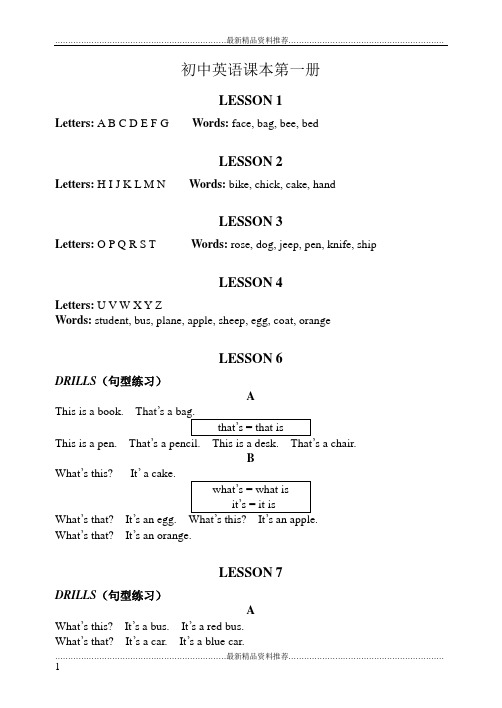
初中英语课本第一册LESSON 1Letters: A B C D E F G Words: face, bag, bee, bedLESSON 2Letters: H I J K L M N Words: bike, chick, cake, handLESSON 3Letters: O P Q R S T Words: rose, dog, jeep, pen, knife, shipLESSON 4Letters: U V W X Y ZWords: student, bus, plane, apple, sheep, egg, coat, orangeLESSON 6DRILLS(句型练习)AThis is a book. That’This is a pen. That’s a chair.BWhat’s this? It’ a cake.What’s that? It’s an egg.What’s that? It’s an orange.LESSON 7DRILLS(句型练习)AWhat’s this? It’s a bus. It’s a red bus.What’s that? It’s a car. It’s a blue car.BIs this a jeep? Yes, it is. Is it green? Yes, it is.CIs this a ship? Yes, it is. What colour is it? It’s yellow.Is that a plane? Yes, it is. What colour is it? It’s white.DIALOGUE(对话)A:What colour is this apple?B:It’s red.A:What colour is that banana?B:It’s yellow.A:What colour is an orange?B:Why, it’s orange. An orange is orangeLESSON 8DRILLS(句型练习)AThis is my cup. It isn’t your cup. My cup is white. Your cup is yellow. That isn’t his bike. It’Her bike is green.Is this your desk? Yes, it is. Is that your chair? No, it isn’t. It’s his chair. Is this your rubber? Yes, it is. Is that your ruler? No, it isn’t. It’s her ruler. DIALOGUE(对话)Tom:Kate!Kate:Yes?Tom:Is this your knife?Kate:No, it isn’t.* * *Kate:Tom! Is this your pencil-box?Tom:Yes, it is. Thank you.Kate:That’s all right.LESSON 9DRILLS(句型练习)Aone ship; two ships; three cakes; four coats; five beds;six bees; seven bananas; eight oranges; nine buses; ten boxes;BThese are apples. Those aren’t apples. They’re oranges.The apples are here.These are desks.The desks are here. The tables are there.DIALOGUE(对话)A:Look,what’s this?B:It’s a ship.A:No,it’s a sheep. These are all sheep. They’re white sheep. What are those? B:Why, they’re sheep, too. They’re black sheep.A:No, they aren’t sheep. They’re goats.GRAMMAR(语法)名词的复数形式(The Plural Number of Nouns)(Ⅰ)1、一般在单数名词末尾加-s:book-----books ruler-----rulers egg-----eggs student-----students hand-----hands rose-----roses orange-----oranges2、以s、x等结尾的词加-es:bus-----buses box-----boxes注:knife的复数形式为knives,sheep的复数形式和单数形式相同。
外研版八年级英语上册全部课文及翻译
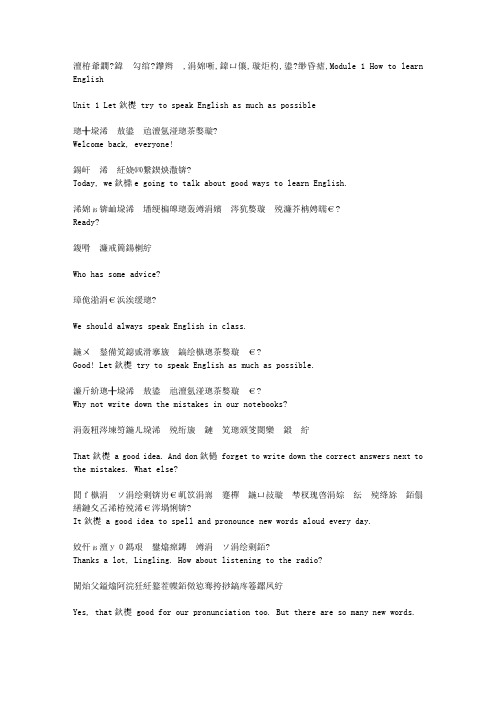
澶栫爺鐗?鍏勾绾?鑻辫,涓婂唽,鍏ㄩ儴,璇炬枃,鍙?缈昏瘧,Module 1 How to learn EnglishUnit 1 Let鈥檚 try to speak English as much as possible璁╂垜浠敖鍙兘澶氬湴璁茶嫳璇?Welcome back, everyone!鍚屽浠紝娆㈣繋鍥炴潵锛?Today, we鈥檙e going to talk about good ways to learn English.浠婂ぉ锛屾垜浠墦绠楄皥璁轰竴涓嬪涔犺嫳璇殑濂芥柟娉曘€?Ready?鍑嗗濂戒簡鍚楋紵Who has some advice?璋佹湁涓€浜涘缓璁?We should always speak English in class.鍦ㄨ鍫備笂鎴戜滑搴旇鎬绘槸璁茶嫳璇€?Good! Let鈥檚 try to speak English as much as possible.濂斤紒璁╂垜浠敖鍙兘澶氬湴璁茶嫳璇€?Why not write down the mistakes in our notebooks?涓轰粈涔堜笉鍦ㄦ垜浠殑绗旇鏈笂璁颁笅閿欒鍛紵That鈥檚 a good idea. And don鈥檛 forget to write down the correct answers next to the mistakes. What else?閭f槸涓ソ涓绘剰锛岃€屼笖涓嶈蹇樿鍦ㄩ敊璇梺杈瑰啓涓婃纭殑绛旀銆傝繕鏈夊叾浠栫殑浠€涔堝悧锛?It鈥檚 a good idea to spell and pronounce new words aloud every day.姣忓ぉ澶у0鎷艰鐢熻瘝鏄竴涓ソ涓绘剰銆?Thanks a lot, Lingling. How about listening to the radio?闈炲父鎰熻阿浣狅紝鐜茬幉銆傚惉骞挎挱鎬庝箞鏍凤紵Yes, that鈥檚 good for our pronunciation too. But there are so many new words.鏄殑锛岄偅涔熸湁鐩婁簬鎴戜滑鐨勫彂闊炽€備絾鏈夊緢澶氱敓璇嶃€?You don鈥檛 need to understand every word. You just need to listen for key words and main ideas.浣犱滑涓嶅繀鐞嗚В姣忎釜鍗曡瘝锛堢殑鍚箟锛夈€備綘浠彧闇€瑕佸惉鍏抽敭璇嶅拰涓昏鎰忔€濄€?That鈥檚 the same for reading. English stories are so interesting. I get to know a lot about the world through reading.闃呰涔熶竴鏍枫€傝嫳璇晠浜嬪姝ゆ湁瓒c€傞€氳繃闃呰鎴戦€愭笎浜嗚В浜嗕笘鐣屼笂鐨勮澶氫簨鎯呫€?I think writing is also important. Why don鈥檛 we try to find some English pen friends? We can write to them.鎴戣涓哄啓浣滀篃寰堥噸瑕併€傛垜浠负浠€涔堜笉灏介噺鍘绘壘浜涜鑻辫鐨勭瑪鍙嬪憿锛熸垜浠彲浠ョ粰浠栦滑鍐欎俊銆?Excellent! I agree with you.澶浜嗭紒鎴戝悓鎰忎綘锛堢殑鎻愯锛夈€?Unit 2 You should smile at her!浣犲簲璇ュ悜濂瑰井绗戯紒Many students ask for advice about how to improve their English.寰堝瀛︾敓鍜ㄨ濡備綍鎻愰珮浠栦滑鑻辫姘村钩鐨勫缓璁€?Here are three questions.杩欏効鏄笁涓熀鏈棶棰樸€?The first question is about understanding English films and songs.绗竴涓棶棰樻槸鍏充簬鐞嗚В鑻辨枃鐢靛奖鍜屾瓕鏇茬殑闂銆?Li Hao from Hubei wrote, 鈥淚 like watching English films and listening to English songs, but I can only understand a little. What can I do?鈥?鏉ヨ嚜婀栧寳鐨勬潕娴╁啓閬擄細鈥滄垜鍠滄鐪嬭嫳鏂囩數褰憋紝鍚嫳鏂囨瓕鏇诧紝浣嗘垜鍙兘鐞嗚В涓€鐐瑰効銆傛垜鍙互鎬庝箞鍋氬憿锛熲€?Watching films and listening to songs are great ways to learn English!鐪嬬數褰卞拰鍚瓕鏇叉槸瀛︿範鑻辫鐨勫緢濂界殑鏂瑰紡锛?Watch and listen several times, and guess the meaning of the new words.鐪嬩笂鎴栧惉涓婂嚑閬嶏紝骞剁寽娴嬬敓璇嶇殑鍚箟銆?Each time you will learn something new.姣忎竴閬嶄綘閮戒細瀛﹀埌鏂颁笢瑗裤€?I also advise you to talk about the films or songs with your friends.鎴戣繕寤鸿浣犲拰鏈嬪弸浠皥璁轰竴涓嬭繖浜涚數褰辨垨姝屾洸銆?The second question is about speaking.绗簩涓棶棰樻槸鍏充簬璇寸殑銆?Wang Fan from Jilin wrote, 鈥淥ur school has a teacher from the US. I am shy and I am afraid to speak to her. What should I do?鈥?鏉ヨ嚜鍚夋灄鐨勭帇甯嗗啓閬擄細鈥滄垜浠鏍℃湁涓€浣嶆潵鑷編鍥界殑鑰佸笀銆傛垜寰堣吋鑵嗭紝涓嶆暍涓庡ス璇磋瘽銆傛垜璇ユ€庝箞鍔炲憿锛熲€?You can say, 鈥淗ello! How are you?鈥?鈥淒o you like China?鈥?These are good ways to start a conversation.浣犲彲浠ヨ锛氣€滃棬锛佷綘濂藉悧锛熲€濃€滀綘鍠滄涓浗鍚楋紵鈥濊繖浜涢兘鏄睍寮€浜よ皥鐨勫ソ鏂瑰紡銆?And before you begin, you should smile at her!鍦ㄤ綘寮€濮嬶紙璁茶嫳璇級鍓嶏紝浣犲簲璇ュ悜濂瑰井绗戯紒Remember this: Do not be shy. Just try.璁颁綇杩欎竴鐐癸細涓嶈瀹崇緸锛屽幓璇曚竴璇曘€?The third question is about vocabulary.绗笁涓棶棰樻槸鍏充簬璇嶆眹鐨勩€?Zhang Lei from Anhui wrote, 鈥淚 write down new words, but I forget them quickly. How can I remember them?鈥?鏉ヨ嚜瀹夊窘鐨勫紶闆峰啓閬擄細鈥滄垜鍐欎笅鐢熻瘝锛屼絾鎴戝緢蹇氨蹇樿浜嗗畠浠€傛垜鎬庢牱鎵嶈兘璁颁綇瀹冧滑鍛紵鈥?Do not worry. It is natural to forget new words!涓嶇敤鎷呭績锛屽繕璁扮敓璇嶆槸寰堣嚜鐒剁殑锛?I suggest you write four or five words a day on pieces of paper and place them in your room.鎴戝缓璁綘姣忓ぉ鎶?涓垨5涓崟璇嶅啓鍦ㄧ焊鐗囦笂骞舵斁鍦ㄤ綘鐨勬埧闂撮噷銆? Read the words when you see them, and try to use them.鐪嬪埌杩欎簺鍗曡瘝鐨勬椂鍊欏氨璇讳竴璇伙紝骞朵笖灏介噺浣跨敤瀹冧滑銆?Module 2 My hometown and my country鎴戠殑瀹朵埂鍜屾垜鐨勫浗瀹?Unit 1 It鈥檚 taller than many other buildings.。
【金识源】八年级英语上册unit1unit1(1unit2)教案
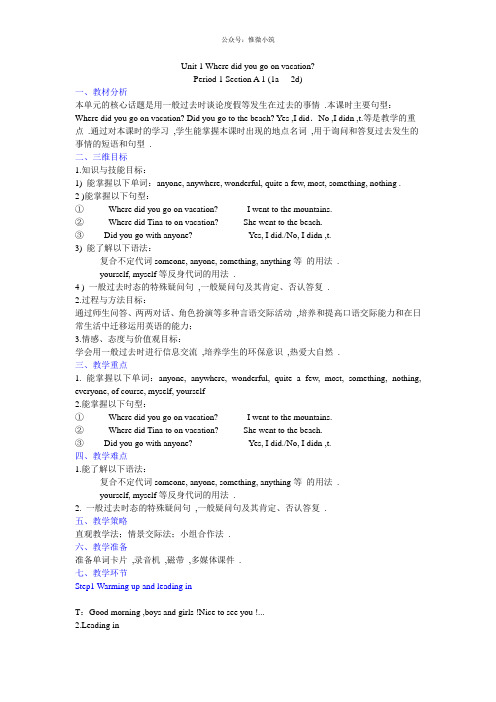
Unit 1 Where did you go on vacation?Period 1 Section A 1 (1a -2d)一、教材分析本单元的核心话题是用一般过去时谈论度假等发生在过去的事情.本课时主要句型:Where did you go on vacation? Did you go to the beach? Yes ,I did.No ,I didn ,t.等是教学的重点.通过对本课时的学习,学生能掌握本课时出现的地点名词,用于询问和答复过去发生的事情的短语和句型.二、三维目标1.知识与技能目标:1) 能掌握以下单词:anyone, anywhere, wonderful, quite a few, most, something, nothing .2 )能掌握以下句型:①-Where did you go on vacation? -I went to the mountains.②-Where did Tina to on vacation? -She went to the beach.③-Did you go with anyone? -Yes, I did./No, I didn ,t.3) 能了解以下语法:-复合不定代词someone, anyone, something, anything等的用法.-yourself, myself等反身代词的用法.4 ) 一般过去时态的特殊疑问句,一般疑问句及其肯定、否认答复.2.过程与方法目标:通过师生问答、两两对话、角色扮演等多种言语交际活动,培养和提高口语交际能力和在日常生活中迁移运用英语的能力;3.情感、态度与价值观目标:学会用一般过去时进行信息交流,培养学生的环保意识,热爱大自然.三、教学重点1. 能掌握以下单词:anyone, anywhere, wonderful, quite a few, most, something, nothing, everyone, of course, myself, yourself2.能掌握以下句型:①-Where did you go on vacation? -I went to the mountains.②-Where did Tina to on vacation? -She went to the beach.③-Did you go with anyone? -Yes, I did./No, I didn ,t.四、教学难点1.能了解以下语法:-复合不定代词someone, anyone, something, anything等的用法.-yourself, myself等反身代词的用法.2. 一般过去时态的特殊疑问句,一般疑问句及其肯定、否认答复.五、教学策略直观教学法;情景交际法;小组合作法.六、教学准备准备单词卡片,录音机,磁带,多媒体课件.七、教学环节Step1 Warming up and leading inT:Good morning ,boys and girls !Nice to see you !...2.Leading inT:What did you do last weekend?Now let ,s talk.看动画片来进入本课时的主题谈论上周末做了些什么事情,谈论过去发生的事情.Step 2 Presentation1. Show some pictures on the big screen. Let Ss read the expressions.2. Focus attention on the picture. Ask: What can you see? Say: Each picture showssomething a person did in the past. Name each activity and ask students to repeat:Stayed at home, Went to mountains, went to New York City 6. Went to the beach,visited my uncle, visited museums, went to summer camp3. Now, please match each phrase with one of the pictures next to the name of theactivity ,point to the sample answer.4. Check the answers. Answers: 1. f 2. b 3. g 4. e5. c6. a7. dStep 3 Listening :1a and 1b1. Point to the picture on the screen.Say: Look at the picture A. Where did Tina go on vacation? She went to the mountains.Ask: What did the person do in each picture?2. Play the recording the first time.3. Play the recording a second time.Say: There are three conversations. The people talk about what did on vacation. Listen to the recording and write numbers of the names in the right boxes of the picture.4. Check the answers.5. Pair work :1c1 )Point out the sample conversation. Ask two Ss to read the conversation to the class.2 ) Now work with a partner. Make your own conversation about the people in the picture.3 ) Ss work in pairs. As they talk, move around the classroom and give any help they need.4 ) Let some pairs act out their conversations.Step 4 Listening:2a and 2b1. Tell Ss they will hear a conversation about three students , conversations. Listen for the first time and fill in the chart. Then listen again and check Yes, or No.2. Let Ss read the phrases in the chart of 2b.3. Play the recording the first time. Ss listen and fill in the chart.4. Play the recording a second time for the Ss to check "Yes, I did.〞or "No, I didn ,t. 〞5. Check the answers with the Ss.6. Pair work :2c1 ) Let two Ss read the conversation between Grace, Kevin and Julie.2 ) Let Ss work in pairs and try to role -play the conversation.3 ) Ask some pairs to act out their conversations.Step 5 Role -play1. First let Ss read the conversation and match the people and places they went.2. Let Ss act out the conversations in pairs.3. Some explanations in 2d.Step 6 SummaryWhat have you learned in this lesson?(让学生自己总结这节课中学到了什么.)Step 7 Homework用英语询问你的一位好朋友,她(他)假期去了哪里?看到了什么?并将此对话写在作业上.A: Where did you go… ? B: I went to…A: Did you see…B: Yes, I did. / No, I didn ,t.八、板书设计:。
年代80初中英语第三册

年代80初中英语第三册There were no classesthis afternoon. My classmatesall went to the Summer Palace. They had a good time, but I didn?t go.After lunch Aunt Huang came in. she looker worried. “Grandma is ill, ” she said.“Imust take her to the hospital. Bu t my baby,? I can?t leave her by herself.”Mother and Dad were not at home. So I said, “Don?t worry. I can look 12 页354925555.doc 长征录入after her,”“Thank you, Xiao Ping. Thank you.”Then she left.The baby was about ten months old. At first she was asleep. Half an hour later she woke up. She couldn?t find her mother and began to cry.“Don?t cry,”said. I talked to her. But she looked at me and cried harder and harder.I turned on the radio. She stopped crying and listened to the music. Aftera few minutes she started to cry again.“Listen to me,”I said. I started to sing. The baby watched and listened. She didn?t cry any more. Then I made faces andjumped like a monkey. The baby laughed and laughed.All that afternoon I jumped and sang and did all kinds of things. When Aunt Huang came back, I was tired.In the evening Wang Lin came to see me. I told him the whole story. He laughed. “You?re great! I?m going to tell everyone. I?m going to tell them ,Bring your babies to Li Ping. He can take good care of your babies?”. LESSON 9DRILLS (句型练习)John writes more carefully than Tom and Peter.Right. He writes the most carefully of the three.AA:Which picture ismore beautiful?more interesting?more expensive?B:The oneon the left,I think.on the right,on the left,BA:Which lesson isthe most difficultin Book Two?the most interestingthe most instructiveLesson 15 is. Don’tyou think so? Lesson 13Lesson 6CA:Tomdraws betterthan Peter.jumps higherwrites more carefully13 页354925555.doc 长征录入B:You’re quite right. Hedraws the bestin our class. jumps the highestwrites the most carefullyDA:Is Joan astallas Kate?strongcarefulB:No, she isn’t. She isn’tquite astallas Kate.strongcareful(Yes, she’s just as tall as Kate.)DIALOGUE (对话)THEMOONSon:Look, Dad! How bright and near the moon looks tonight!Father:But it isn?t as near as it looka.Son:I know it?s far away from the earth.Father:It ?s three hundred and eighty thousand kilometers away.Son:How far is that?Father:Well, it takes more than three days to get there by spaceship. Son:A spaceship flies very, very fast, doesn?t it?Father:Yes. It flies at about eleven kilometers a second. In 1969 twoAmericans got to the moon by spaceship. That was one of the most exciting moments of that year.Son:They didn?t find any living things there, did they?Father: No, they didn?t. It?s too hot in the day and too cold at night. And there?s no air or water there. Nothing can live on the moon.Son:I hear walking on the moon is more difficult. It ?s like jumping andflying. Is that so?Father:Yes, isn?t that interesting! Everything is much lighter on the moon.You can jump much higher on the moon than on the earth.Son:I wish I could fly to the moon in a spaceship one day. It must be greatfun.NOTESIt ’s three hundred and eight thousand kilometers away.它(月球)三十八万公里。
九年义务教育三年制初级中学教科书英语第一册

九年义务教育是指在我国实施的义务教育制度中,对适龄儿童和少年实行的义务教育有九年制的规定。
而初级中学教科书英语第一册则是九年义务教育中的一部分,它在教育体系中扮演着重要的角色。
接下来将从以下几个方面来介绍九年义务教育和初级中学教科书英语第一册。
1.九年义务教育的背景和意义九年义务教育的实施,是我国教育改革的一项重要政策。
其背景是为了让更多的儿童和少年接受到较为完整的初等教育,提高整个国家的文化素质和科学知识水平。
也是为了实现全面建设小康社会的战略目标,培养更多的高素质人才,推动经济社会的可持续发展。
九年义务教育的实施具有深远的意义,不仅对于个体的成长和发展有着重要的影响,也对国家的未来发展起着重要的推动作用。
2.初级中学教科书英语第一册的编写目的和重要性初级中学教科书英语第一册是九年义务教育中的重要教材之一。
它的编写目的主要是为了帮助学生打好英语学习基础,提高学生的英语听、说、读、写能力,使学生能够在日常生活和学习中灵活运用英语进行交流。
通过学习英语,也能够开拓学生的国际视野,增加对外国文化和历史的了解,促进学生的全面发展。
初级中学教科书英语第一册的编写具有重要的理论和实践意义,对于学生的英语学习和发展起着至关重要的作用。
3.初级中学教科书英语第一册的内容概述初级中学教科书英语第一册主要包括基本的英语语音、语法知识,以及日常交际用语和基本的阅读和写作技能。
其中,涵盖了多种日常生活场景和话题,如家庭、学校、朋友、节日等,同时也会引导学生对一些简单的英语文章进行阅读和理解,培养学生的阅读能力。
通过这些内容的学习,学生不仅能够掌握基本的英语知识和技能,而且能够在实际生活中进行简单的英语交流和表达。
4.初级中学教科书英语第一册的教学方法和特点在教学方法上,初级中学教科书英语第一册注重培养学生的英语实际运用能力,倡导以学生为中心的教学模式,注重启发式教学,激发学生学习的兴趣和主动性。
教科书中也设计了丰富多样的教学活动和练习题,以帮助学生巩固知识、提高能力。
80年代初中英语第一册
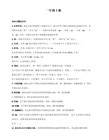
LESSON 14
DRILLS(句型练习)
A
I’m a boy. You’re a girl. She’s a girl. You’re girls.
I’m a student. You’re students. We’re all students.
B:Why, they’re sheep, too. They’re black sheep.
A:No, they aren’t sheep. They’re goats.
GRAMMAR(语法)
名词的复数形式(The Plural Number of Nouns)(Ⅰ)
1、一般在单数名词末尾加-s:
What’s that? It’s an orange.
LESSON 7
DRILLS(句型练习)
A
What’s this? It’s a bus. It’s a red bus.
What’s that? It’s a car. It’s a blue car.
B
Is this a jeep? Yes, it is. Is it green? Yes, it is.
who’s = who is
Who’s this woman? She’s Li Ping’s mother. Is she a teacher, too?
No, she isn’t. She’s a worker.
C
These two boys are Jack and Mike. They aren’t Chinese.
C
Is this a ship? Yes, it is. What colour is it? It’s yellow.
《初中英语》(第一册)

[W]in[T]in[M]prep.在…(内,上)[v]40220-42680
[W]row[T]r3u, rou[M]n.(一)排;(一)行[v]42680-45252
[W]too[T]tu:[M]adv.也[v]45252-47877
[W]are[T]1:[M]v.是
[W]everyone[T]'evriw2n[M]pron.每人,人人[v]203358-206130
[W]here[T]hi3[M]adv.这里,这儿[v]206130-208598
[W]today[T]t3'dei[M]n.&adv.今天[v]208598-211257
[W]at[T]5t[M]prep.在[v]211257-213588
[W]double[T]'d2b3l[M]adj.双的;双重的[v]35300-37767
[W]good-bye[T]gud'bai[M]interj.再见
[W]number[T]'n2mb3[M]n.数字;号码
[W]in English[T]in'i9gli7[M]用英语
[W]I[T]ai[M]pron.我[v]37767-40220
[W]bird[T]b3:d[M]n.鸟[v]168014-170643
[W]its[T]its[M]pron.它的
[W]do[T]du, du:[M]v.aux.助动词(无词意)[v]170643-173052
[W]know[T]n3u[M]vt.知道;懂得[v]173052-175548
[W]it[T]it[M]pron.它[v]15270-17718
80年代中学英语教材回忆
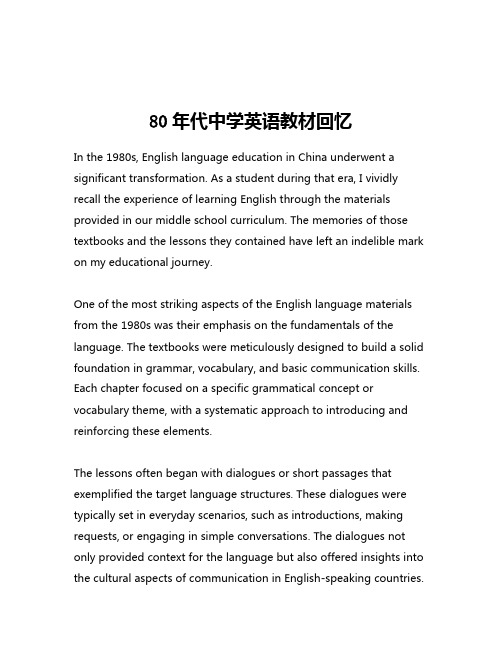
80年代中学英语教材回忆In the 1980s, English language education in China underwent a significant transformation. As a student during that era, I vividly recall the experience of learning English through the materials provided in our middle school curriculum. The memories of those textbooks and the lessons they contained have left an indelible mark on my educational journey.One of the most striking aspects of the English language materials from the 1980s was their emphasis on the fundamentals of the language. The textbooks were meticulously designed to build a solid foundation in grammar, vocabulary, and basic communication skills. Each chapter focused on a specific grammatical concept or vocabulary theme, with a systematic approach to introducing and reinforcing these elements.The lessons often began with dialogues or short passages that exemplified the target language structures. These dialogues were typically set in everyday scenarios, such as introductions, making requests, or engaging in simple conversations. The dialogues not only provided context for the language but also offered insights into the cultural aspects of communication in English-speaking countries.Following the dialogues, the textbooks would delve into detailed explanations of the grammatical rules and patterns. The explanations were often accompanied by numerous practice exercises, ranging from fill-in-the-blank activities to sentence transformation exercises. This emphasis on grammar and structural mastery was a hallmark of the English language education during that time, as it was believed to be the foundation for effective language acquisition.In addition to the grammatical focus, the textbooks also included a significant portion dedicated to vocabulary development. Each chapter would introduce a set of new words and phrases, often organized around a specific theme or topic. The vocabulary sections would include definitions, sample sentences, and opportunities for students to practice using the new words in context.One aspect of the 1980s English language materials that I particularly appreciated was the inclusion of reading comprehension passages. These passages, which ranged from short stories to informative articles, not only exposed us to authentic English texts but also challenged us to develop our reading and analytical skills. The passages often covered a variety of topics, from history and culture to science and technology, broadening our understanding of the English-speaking world.The reading comprehension exercises that followed the passages were designed to test our understanding of the content, as well as our ability to infer meaning and draw conclusions. These exercises often involved answering comprehension questions, identifying the main ideas, and even engaging in discussions or written responses to the passages.One distinctive feature of the English language materials from the 1980s was the emphasis on translation exercises. These exercises required us to translate passages or sentences from Chinese to English and vice versa. While the focus on translation may seem outdated in today's language learning approaches, it was a crucial component of the educational system at the time, as it was believed to enhance our understanding of the differences between the two languages and improve our overall language proficiency.The 1980s English language materials also incorporated a significant amount of listening and speaking practice. Audio recordings, often featuring native English speakers, were used to expose us to authentic pronunciation and intonation patterns. The accompanying exercises would involve listening comprehension tasks, such as answering questions or filling in the blanks based on the audio recordings.In terms of speaking practice, the textbooks often included role-playing activities and dialogues that we were required to perform in class. These activities not only helped us improve our conversational skills but also fostered a sense of confidence in using the language in real-life situations.Looking back on my experiences with the English language materials from the 1980s, I can appreciate the comprehensive and systematic approach they took to language education. While the focus on grammar and translation may seem outdated in today's communicative language teaching methods, the foundation it provided was invaluable in shaping my understanding and proficiency in the English language.The meticulous attention to detail, the emphasis on practice and reinforcement, and the exposure to a wide range of topics and cultural contexts all contributed to the development of my language skills. The memories of those textbooks and the lessons they contained have remained with me, serving as a testament to the dedication and foresight of the educators who designed them.As language learning continues to evolve, it is important to acknowledge the contributions of the past and recognize the valuable lessons that can be drawn from the educational approaches of previous eras. The 1980s English language materials, with their focus on fundamentals and their commitment to comprehensivelanguage education, have left an indelible mark on the language learning experiences of countless students like myself.。
八十年代初中英语课本电子书
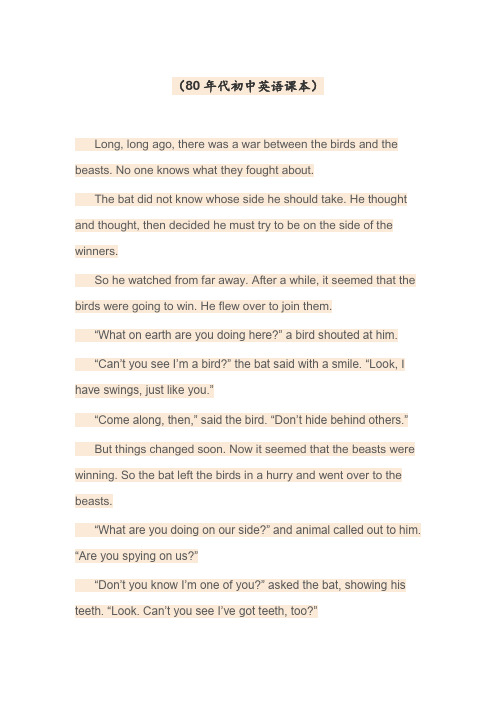
(80年代初中英语课本)Long, long ago, there was a war between the birds and the beasts. No one knows what they fought about.The bat did not know whose side he should take. He thought and thought, then decided he must try to be on the side of the winners.So he watched from far away. After a while, it seemed that the birds were going to win. He flew over to join them.“What on earth are you doing here?” a bird shouted at him.“Can’t you see I’m a bird?” the bat said with a smile. “Loo k, I have swings, just like you.”“Come along, then,” said the bird. “Don’t hide behind others.”But things changed soon. Now it seemed that the beasts were winning. So the bat left the birds in a hurry and went over to the beasts.“What are you doing on our side?” and animal called out to him. “Are you spying on us?”“Don’t you know I’m one of you?” asked the bat, showing his teeth. “Look. Can’t you see I’ve got teeth, too?”“Who are trying to fool?” said the animals. “We saw you fighting on the side of the birds just now.”So the beasts drove him off. Of course the birds refused to take him back.When the beasts and the birds saw neither side could win, they decided to stop fighting.Neither beasts nor birds would have the bat as their friend, so he was afraid to leave his home. Ever since then, he comes out only at night.。
80年代中学英语教材参考用书

80年代中学英语教材参考用书The English Textbook Reference Books of the 1980sThe 1980s was a significant period for English education in many countries around the world. In this era, the demand for effective English textbook reference books was on the rise, as educators sought to provide students with comprehensive resources to support their language learning. These reference books played a crucial role in shaping the educational landscape and influencing the way English was taught and learned during this time.One of the primary reasons for the increased importance of English textbook reference books in the 1980s was the growing recognition of the global significance of the English language. As globalization and international cooperation gained momentum, the ability to communicate effectively in English became increasingly valuable. Governments and educational institutions recognized the need to invest in high-quality English language instruction to prepare their citizens for the challenges of the modern world.The 1980s also saw a shift in the approach to language learning, with a greater emphasis on communicative competence and the practicalapplication of language skills. Traditional grammar-based instruction was gradually replaced by more interactive and task-oriented methodologies, which required the development of comprehensive reference materials to support this new approach.One of the key features of the English textbook reference books of the 1980s was their focus on providing students with a holistic understanding of the language. These resources often included not only detailed grammatical explanations and vocabulary lists but also exercises, dialogues, and cultural information. This comprehensive approach aimed to equip learners with the necessary linguistic knowledge and cultural awareness to engage in meaningful communication in English.Another important aspect of these reference books was their adaptability to different learning contexts and proficiency levels. As the demand for English education grew, educators recognized the need for resources that could cater to the diverse needs of students, from beginners to advanced learners. The best English textbook reference books of the 1980s were designed to be flexible and versatile, allowing teachers to tailor their instruction to the specific requirements of their students.In addition to their educational value, these reference books also played a significant role in shaping the broader cultural landscape.Through the inclusion of cultural content and the presentation of diverse perspectives, these resources contributed to the dissemination of knowledge and the promotion of intercultural understanding. This was particularly important in an era when the world was becoming increasingly interconnected, and the need for cross-cultural communication and collaboration was on the rise.The impact of the English textbook reference books of the 1980s can still be felt today. Many of the principles and approaches developed during this period continue to inform language teaching and learning practices worldwide. The emphasis on communicative competence, the integration of cultural elements, and the adaptability to diverse learning contexts have all become hallmarks of effective language education.As we reflect on the legacy of these reference books, it is important to acknowledge the dedication and innovation of the educators, linguists, and publishers who worked tirelessly to create these resources. Their efforts laid the foundation for the continued evolution of English language education, ensuring that students around the world had access to the tools and resources they needed to become proficient and confident communicators in the global arena.In conclusion, the English textbook reference books of the 1980splayed a pivotal role in shaping the educational landscape and promoting the widespread adoption of the English language. These resources not only provided students with the necessary linguistic knowledge but also fostered cultural understanding and prepared learners for the challenges of the modern world. The legacy of these reference books continues to inspire and guide language educators today, as they strive to create engaging and effective learning experiences for their students.。
80年代的初中英语教材
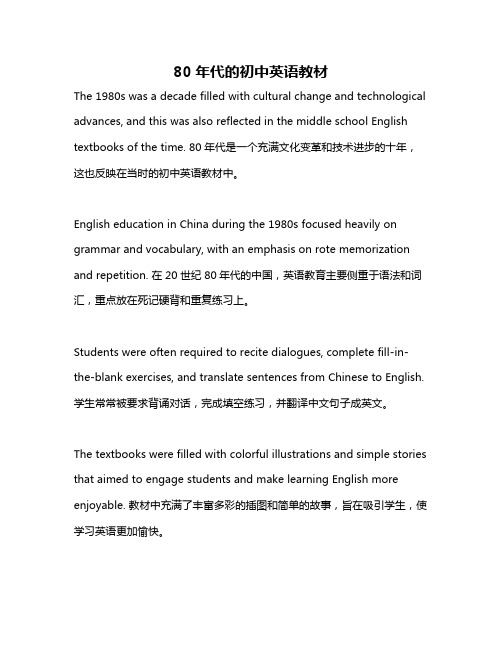
80年代的初中英语教材The 1980s was a decade filled with cultural change and technological advances, and this was also reflected in the middle school English textbooks of the time. 80年代是一个充满文化变革和技术进步的十年,这也反映在当时的初中英语教材中。
English education in China during the 1980s focused heavily on grammar and vocabulary, with an emphasis on rote memorization and repetition. 在20世纪80年代的中国,英语教育主要侧重于语法和词汇,重点放在死记硬背和重复练习上。
Students were often required to recite dialogues, complete fill-in-the-blank exercises, and translate sentences from Chinese to English. 学生常常被要求背诵对话,完成填空练习,并翻译中文句子成英文。
The textbooks were filled with colorful illustrations and simple stories that aimed to engage students and make learning English more enjoyable. 教材中充满了丰富多彩的插图和简单的故事,旨在吸引学生,使学习英语更加愉快。
One of the most memorable aspects of 80s English textbooks was the inclusion of popular songs and rhymes, which helped students learn pronunciation and rhythm. 80年代英语教材最令人难忘的一点是包含了流行歌曲和韵律,这有助于学生学习发音和节奏。
初级中学英语新目标初级中学一年级英语第一学期上册unit 8 When is your birthd
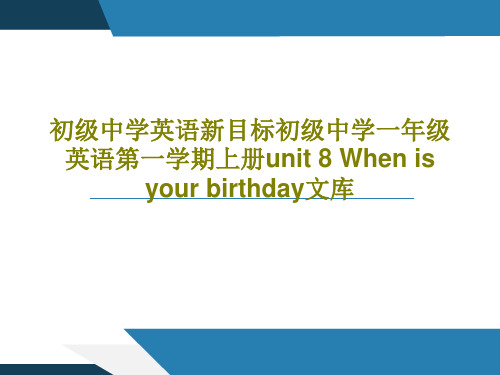
61、奢侈是舒适的,否则就不是奢侈 。——CocoCha nel 62、少而好学,如日出之阳;壮而好学 ,如日 中之光 ;志而 好学, 如炳烛 之光。 ——刘 向 63、三军可夺帅也,匹夫不可夺志也。 ——孔 丘 64、人生就是学校。在那里,与其说好 的教师 是幸福 ,不如 说好的 教师是 不幸。 ——海 贝尔 65、接受挑战,就可以享受胜利的喜悦 。——杰纳勒 尔·乔治·S·巴顿
初级中学英语新目标初级中学一年级 英语第一学期上册unit 8 W法 纳西耶 夫 2、改革如果不讲纪律,就难以成功。
3、道德行为训练,不是通过语言影响 ,而是 让儿童 练习良 好道德 行为, 克服懒 惰、轻 率、不 守纪律 、颓废 等不良 行为。 4、学校没有纪律便如磨房里没有水。 ——夸 美纽斯
谢谢!
- 1、下载文档前请自行甄别文档内容的完整性,平台不提供额外的编辑、内容补充、找答案等附加服务。
- 2、"仅部分预览"的文档,不可在线预览部分如存在完整性等问题,可反馈申请退款(可完整预览的文档不适用该条件!)。
- 3、如文档侵犯您的权益,请联系客服反馈,我们会尽快为您处理(人工客服工作时间:9:00-18:30)。
初中英语课本第一册LESSON 1Letters: A B C D E F G Words: face, bag, bee, bedLESSON 2Letters: H I J K L M N Words: bike, chick, cake, handLESSON 3Letters: O P Q R S T Words: rose, dog, jeep, pen, knife, shipLESSON 4Letters: U V W X Y ZWords: student, bus, plane, apple, sheep, egg, coat, orangeLESSON 6DRILLS(句型练习)AThis is a book. That’s a bag.that’s = that isThis is a pen. That’s a pencil. This is a desk. That’s a chair.BWhat’s this? It’ a cake.what’s = what isit’s = it isWhat’s that? It’s an egg. What’s this? It’s an apple.What’s that? It’s an orange.LESSON 7DRILLS(句型练习)AWhat’s this? It’s a bus. It’s a red bus.What’s that? It’s a car. It’s a blue car.BIs this a jeep? Yes, it is. Is it green? Yes, it is.CIs this a ship? Yes, it is. What colour is it? It’s yellow.Is that a plane? Yes, it is. What colour is it? It’s white.DIALOGUE(对话)A:What colour is this apple?B:It’s red.A:What colour is that banana?B:It’s yellow.A:What colour is an orange?B:Why, it’s orange. An orange is orangeLESSON 8DRILLS(句型练习)AThis is my cup. It isn’t your cup. My cup is white. Your cup is yellow. That isn’t his bike. It’s her bike. His bike is black. Her bike is green.isn’t = is notBIs this your desk? Yes, it is. Is that your chair? No, it isn’t. It’s his chair. Is this your rubber? Yes, it is. Is that your ruler? No, it isn’t. It’s her ruler. DIALOGUE(对话)Tom:Kate!Kate:Yes?Tom:Is this your knife?Kate:No, it isn’t.* * *Kate:Tom! Is this your pencil-box?Tom:Yes, it is. Thank you.Kate:That’s all right.LESSON 9DRILLS(句型练习)Aone ship; two ships; three cakes; four coats; five beds;six bees; seven bananas; eight oranges; nine buses; ten boxes;BThese are apples. Those aren’t apples. They’re oranges.The apples are here. The oranges are there.aren’t = are notthey’re = they areThese are desks. Those aren’t desks. They’re tables.The desks are here. The tables are there.DIALOGUE(对话)A:Look,what’s this?B:It’s a ship.A:No,it’s a sheep. These are all sheep. They’re white sheep. What are those? B:Why, they’re sheep, too. They’re black sheep.A:No, they aren’t sheep. They’re goats.GRAMMAR(语法)名词的复数形式(The Plural Number of Nouns)(Ⅰ)1、一般在单数名词末尾加-s:book-----books ruler-----rulers egg-----eggs student-----students hand-----hands rose-----roses orange-----oranges2、以s、x等结尾的词加-es:bus-----buses box-----boxes注:knife的复数形式为knives,sheep的复数形式和单数形式相同。
LESSON 10DRILLS(句型练习)AWhat are these? They’re pigs. They’re fat.What are those? They’re goats. They’re thin.BAre these horses white? Yes, they are.Are those cows white,too? No, they aren’t. They’re black and white.CAre those chicks? No, they aren’t. Are they cocks? No, they aren’t.What are they, then? They’re hens. They are big, fat hens.DIALOGUE(对话)Kate:What’s in that box, Mum?Mum:Shoes. New shoes for you.Kate:New shoes for me! What colour are they?Mum:Guess.Kate:Are they white?Mum:No, they aren’t.Kate:Are they red?Mum:No.Kate:Are they green, then?Mum:No. Look, they’re blue.Kate:How nice! Thank you, Mum.LESSON 11DRILLS(句型练习)AThis is Kate and this is Joan. Kate’s hair is long. Joan’s hair is short.This is Mike and this is Tom. Tom’s trousers are new. Mike’s trousers are old..BIs Kate’s hair long or short? It’s long.Are Tom’s trousers old or new? They’re new.CWhose room is this? It’s our room. It’s small.Whose books are those? They’re their books. They’re new.DIALOGUE(对话)Kate: Hello, Joan.Joan: Hello, Kate.Kate: Joan, this is Mike. He’s a new student.Joan: Hello, Mike.Mike: Hello, Joan.Mike: Whose seat is this?Kate: It’s Joan’s. Your seat is over there.He’s = he isLESSON 13DRILLS(句型练习)Li Ping is a boy. He’s a Chinese boy. He’s twelve. He’s tall. He’s a student.Li Ying is a girl. She’s Li Ping’s sister. She’s five. She’s short. She isn’t a student.she’s = she isBWho’s this man? He’s Li Ping’s father. Is he a teacher? Yes, he is.who’s = who isWho’s this woman? She’s Li Ping’s mother. Is she a teacher, too? No, she isn’t. She’s a worker.CThese two boys are Jack and Mike. They aren’t Chinese.They’re English. They’re brothers.DWho are these girls? They’re Joan and Kate.Are they English? Yes, they are.Are they sisters? No, they aren’t. They’re friends.DIALOGUE(对话)A: Look at this picture, Li Ping.B: Oh, it’s an old picture. Who’s this man?A: He’s my father.B: Oh, your father?A: Yes. He’s a teacher. And this is my mother.B: Is she a teacher, too?A: No. she’s a worker.B: Who’s this baby?A: Guess!B: Is it your brother?A: No.B: Your sister?A: No.B: Then it’s you! Ha ha!A: Yes, it’s me.LESSON 14DRILLS(句型练习)I’m a boy. You’re a girl. She’s a girl. You’re girls.I’m a student. You’re students. We’re all students.I’m = I amyou’re = you arewe’re = we areBWhat’s your name? My name is Li Ping. How old are you? I’m twelve.Are you a middle-school student? Yes, I am.Are you in Grade Two? No, I’m not. I’m in Grade One.CAre you middle-school students? Yes, we are.Are you in Grade Three? No, we aren’t. We’re in Grade One.Are you Young Pioneers? Yes, we are.DIs your father a doctor? Yes, he is.Is your mother a doctor, too? No, she isn’t. She’s an English teacher.What’s your sister? She’s a nurse.TEXT(课文)My familyI am an English boy. My name is Mike. I am twelve. My sister’s name is Rose. She is fourteen. Rose and I are students. We like school.My father is a teacher. He is a teacher of English. My mother is a nurse. They work hard. My little brother’s name is Jack. He is only four. We all like Jack. GRAMMAR(语法)I. 人称代词和物主代词(Personal and Possessive Pronouns)人称I you he she it we you they代词物主my your his her its our your their 代词II. 动词be (Verb to be)1、I am We areYou are (not) a student. You are (not) students.He is They areShe isIt is (not) a cock. They are (not) cocks.2、Am I …? Yes, you are. No, you aren’t. Are you…?Yes, I am.No, I’m not.Is he (she,it) …?Yes, he (she,it) is.No, he (she,it) isn’t.Are we…?Yes, we(you) are. No, we(you) aren’t. Are you…?Yes, we are.No, we aren’t.Are they…?Yes, they are.No, they aren’t.LESSON 15DRILLS(句型练习)AKate is in the room. She’s near the window. Her bag is on the desk. Her books are in her bag. Her pencils are in her pencil-box.BWhere’s Kate? She’s near the window.Where’s her bag? It’s on the desk.Where are her books? They’re in the bag.Where are her pencils? They’re in the pencil-box.where’s = where isCWhat’s on the table? There’s a glass on it.What’s under the table? There are two balls under it.What’s on the chair? There’s a bag on it.What’s in the bag? There are some bananas in it.there’s = there isDIALOGUE(对话)Mike: Where’s my cap, Mum?Mum: Is it in your room?Mike: No, it isn’t.Mum: Is it on the desk?Mike: No, it isn’t.Mum: Why, Mike, it’s right on your head!* * *Grandma: Where are my glasses, Mike?Mike: Are they on the table?Grandma: No, they aren’t.Mike: Are they in your bag?Grandma: No, they aren’t.Mike: Why, Grandma, they’re right on your nose!LESSON 16DRILLS(句型练习)AThere’s a house in the picture.There’s a dog in front of the house.There are some trees near the house.There are some sheep behind the house.BIs there a big tree beside the house? Yes, there is.Is there a horse under the tree? No, there isn’t.What’s under it, then? A cow.CAre there any flowers in front of the house? Yes, there are.Are there any cows behind the house? No, there aren’t any.What’s behind it, then? Some sheep.TEXT(课文)Our classroomThis is our classroom. It is a nice big room. The windows are big and the walls are white. There is a blackboard on the front of the wall. On the back wall there is a map. It is a map of China.In front of the blackboard there is a big desk. It is for the teacher. There are forty small desks and chairs in the room. They are for us students.What is on the teacher’s desk? There are some flowers. They are for our teacher. We like her. She is a good teacher.LESSON 18DRILLS(句型练习)AHow many minutes are there in an hour? There are sixty minutes in an hour. How many hours are there in a day? There are twenty-four hours in a day.BHow many days are there in a week? There are seven days in a week.How many days are there in a month?There are thirty or thirty-one days in a month.CHow many months are there in a year? There are twelve months in a year.How many days are there in a year?There are three hundred and sixty-five days in a year.DIALOGUE(对话)A: How many people are there in your family, Wang Lin?B: There are five, my grandpa, my father, my mother, my sister and I.A: Is your grandpa a worker?B: Oh, no. He’s old. He’s seventy.A: What’s your father?B: He’s a maths teacher in the No. 19 Middle School.A: Are there many students in his class?B: Yes. There are forty-six.A: Is your mother a teacher, too?B: No. She’s a doctor.A: And your sister?B: She’s a driver, a bus-driver.A: How old is she?B: She’s twenty-three.GRAMMAR(语法)I. There be 结构“There is (are) + 某物(某人)+ 某地(某时)”这样一种句型,大致相当于汉语“某地(某时)有某物(某人)”的说法。
